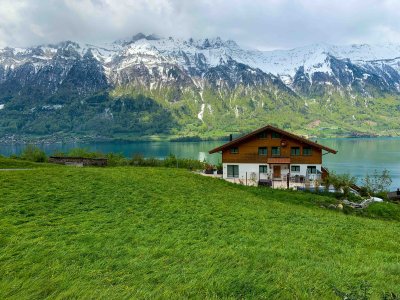Anna Klein
Member
Overview
The Chalet is one of the most recognizable and romantic architectural styles, evoking images of cozy mountain retreats nestled among snow-capped peaks. Originally developed in the Alpine regions of Switzerland, France, Austria, and Italy, chalet architecture has evolved from simple pastoral structures into a globally admired building style known for its rustic charm, timber construction, and harmonious integration with nature.Today, chalets are not confined to the Alps. The style has spread worldwide, influencing residential architecture, resort designs, and luxury homes in mountainous and rural areas.
History of Chalet Architecture
Origins in the Alps
The word "chalet" derives from the Latin "cala" (meaning "shelter"). In the Middle Ages, chalets were primarily used by herders in the Swiss Alps as seasonal dwellings during the summer months. These structures were simple, functional, and made almost entirely of local timber and stone, built to withstand harsh weather conditions.Early chalets typically featured:
- Broad, gently sloping roofs to prevent snow accumulation
- Deep eaves providing shelter from rain and snow
- Heavy use of wood for walls and interiors, offering insulation
- Stone foundations for durability
19th-Century Romanticism
In the 19th century, the industrial revolution brought prosperity, and European elites began to romanticize rural life. The Alpine chalet became a symbol of a simpler, idyllic lifestyle. Chalets evolved from purely utilitarian structures to leisure homes for the wealthy, particularly in Switzerland and France.Artists and writers such as Lord Byron and Johann Wolfgang von Goethe further popularized the romantic vision of Alpine life.
Expansion Beyond the Alps
By the late 19th and early 20th centuries, chalet-style architecture had spread beyond the Alps:- In Germany, it influenced the Bavarian "Heimatstil" movement.
- In France, chalets became fashionable in spa towns.
- In the United States and Canada, chalet design was adapted for mountain lodges and ski resorts, particularly in Colorado, Vermont, and British Columbia.
Modern Chalet Architecture
Today, chalets are no longer limited to rural or mountainous areas. Modern chalets often reinterpret traditional forms with contemporary materials such as glass, steel, and concrete, while still retaining essential elements like pitched roofs, wood cladding, and expansive terraces.Key innovations include:
- Open floor plans
- Panoramic windows to capture views
- Eco-friendly materials and energy-efficient designs
Key Architectural Features
- Roof: Gently sloped or steeply pitched roofs with wide overhangs
- Materials: Predominantly timber and stone; modern versions may include glass and steel
- Balconies and Terraces: Extensive use for outdoor living, often with decorative wood railings
- Windows: Small, shuttered windows traditionally; large picture windows in contemporary chalets
- Interiors: Exposed wooden beams, natural stone fireplaces, cozy and rustic aesthetics
- Integration with Landscape: Designed to harmonize with the natural surroundings
Notable Examples
- Traditional: Historic chalets in Gstaad and Grindelwald, Switzerland
- Modern: Chalet Zermatt Peak (Switzerland), Chalets of Courchevel (France)
- North America: Lake Louise Ski Resort Lodges (Canada), Mountain Chalets in Aspen (USA)
Chalet Variations Around the World
- Swiss Chalets: Archetypal design with richly decorated facades
- French Chalets: Heavier influence from Savoyard stonework
- Canadian Chalets: Larger, more rugged designs adapted to harsh winters
- Scandinavian Influences: Minimalist interpretations, focus on functionality
Influence on Modern Architecture
The chalet style continues to inspire contemporary architecture, particularly in the following areas:- Ski Resorts: Many luxury resorts use modernized chalet designs to attract guests
- Mountain Villas: High-end homes blending rustic charm with cutting-edge technology
- Eco-Resorts: Sustainability combined with traditional aesthetics
- Prefab Chalets: Modular chalets offering affordability and design flexibility
 YouTube Videos
YouTube Videos
- Touring Sir Richard Branson's $100,000/week Swiss Chalet, Verbier Switzerland
- Modern Luxury Chalets of the Alps
 Image Sources
Image Sources

Photo by Aswathy N on Unsplash